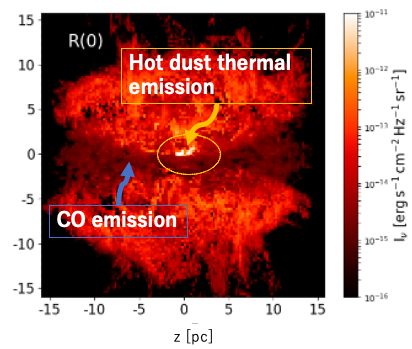Radiative transfer calculations in AGN environments
JAXA Supercomputer System Annual Report April 2020-March 2021
Report Number: R20EDU10502
Subject Category: Space and Astronautical Science
- Responsible Representative: Takao Nakagawa, Professor, Department of Space Astronomy and Astrophysics Institute of Space and Astronautical Science (ISAS)
- Contact Information: Kosei Matsumoto, Department of Space Astronomy and Astrophysics Institute of Space and Astronautical Science (ISAS)(koseim@ir.isas.jaxa.jp)
- Members: Takao Nakagawa, Kosei Matsumoto
Abstract
We performed The CO non-LTE radiative transfer calculation based on the gas structure of the hydrodynamic model and confirmed the consistency with the observational result of CO rovibrational absorption line, and interpreted the observation result theoretically.
Reference URL
N/A
Reasons and benefits of using JAXA Supercomputer System
Radiative transfer calculations handle a 5-dimensional data set that is composed of wavelength gas velocity, and positions (x, y, z) and requires computers plenty of calculation memory in each core. Therefore, SORA-LM has a large memory and is an optimal computer system.
Achievements of the Year
Molecular tori, the geometrically thick donuts-like structures around Active Galactic nucleus (AGN), are important structures that play a role in shielding visible light from the AGN. However, how the geometrically thick structures form and the inner structures of molecular tori are still unknown.
To explore the inner structures, we have observed CO rovibrational absorption lines (Wavelength 4.67 um, v=0-1, delta J=+1,-1) with the dust thermal emission on the inner wall of the tori as the background light. Shirahata et al. (2013) observed CO rovibrational absorption lines with multiple velocity components (-160, 0, +100 km/s), and the excited state showed a Boltzmann distribution at a high temperature (several hundred K). They interpreted the hot components in the molecular torus are heated by AGN, but it is difficult to clarify the origin of the gas components inside the molecular torus with only the observational result.
Therefore, we make mock spectroscopic observations for CO rovibrational absorption lines by performing non-LTE radiative transfer calculations based on the torus structure of the hydrodynamic model, which has been confirmed consistency with a radio wave observation. In the result, we found that CO rovibrational absorption lines with multiple velocity components (-100, 0, +30 km/s) can be observed at inclination angles of 80 to 50 degrees and the redshifted and blueshifted components exists in a high-density region within 2 pc from the center of the AGN at a viewing angle of 77 degrees. This study confirmed the consistency between the observational results and inferred the possible origin of the absorption line, which could not be understood from the observational results alone.

Fig.1: Dust thermal emission and CO line emission of rovibrational transition R(0) at an inclination angle of 77 degree.

Fig.2: CO rovibrational absorptional line spectrum of R(4), R(8), R(16) at an inclination angle of 77 degree.
Publications
– Poster Presentations
Kosei Matsumoto, Taisei Uzuo, Keiichi Wada, Shunsuke Baba, Takao Nakagawa, Shusuke Onishi “Probing inner structures of molecular torus with CO ro-vibrational absorption lines”,Dust2020 in Marseille
Usage of JSS
Computational Information
- Process Parallelization Methods: MPI
- Thread Parallelization Methods: N/A
- Number of Processes: 32 – 128
- Elapsed Time per Case: 24 Hour(s)
Resources Used(JSS2)
Fraction of Usage in Total Resources*1(%): 0.00
Details
Please refer to System Configuration of JSS2 for the system configuration and major specifications of JSS2.
| System Name | Amount of Core Time(core x hours) | Fraction of Usage*2(%) |
|---|---|---|
| SORA-MA | 0.00 | 0.00 |
| SORA-PP | 20.34 | 0.00 |
| SORA-LM | 0.52 | 0.00 |
| SORA-TPP | 0.00 | 0.00 |
| File System Name | Storage Assigned(GiB) | Fraction of Usage*2(%) |
|---|---|---|
| /home | 7.95 | 0.01 |
| /data | 79.47 | 0.00 |
| /ltmp | 1,627.60 | 0.14 |
| Archiver Name | Storage Used(TiB) | Fraction of Usage*2(%) |
|---|---|---|
| J-SPACE | 0.00 | 0.00 |
*1: Fraction of Usage in Total Resources: Weighted average of three resource types (Computing, File System, and Archiver).
*2: Fraction of Usage:Percentage of usage relative to each resource used in one year.
Resources Used(JSS3)
Fraction of Usage in Total Resources*1(%): 0.00
Details
Please refer to System Configuration of JSS3 for the system configuration and major specifications of JSS3.
| System Name | Amount of Core Time(core x hours) | Fraction of Usage*2(%) |
|---|---|---|
| TOKI-SORA | 0.00 | 0.00 |
| TOKI-RURI | 0.00 | 0.00 |
| TOKI-TRURI | 0.00 | 0.00 |
| File System Name | Storage Assigned(GiB) | Fraction of Usage*2(%) |
|---|---|---|
| /home | 14.31 | 0.01 |
| /data | 143.05 | 0.00 |
| /ssd | 143.05 | 0.07 |
| Archiver Name | Storage Used(TiB) | Fraction of Usage*2(%) |
|---|---|---|
| J-SPACE | 0.00 | 0.00 |
*1: Fraction of Usage in Total Resources: Weighted average of three resource types (Computing, File System, and Archiver).
*2: Fraction of Usage:Percentage of usage relative to each resource used in one year.
JAXA Supercomputer System Annual Report April 2020-March 2021


